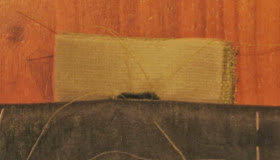 |
| I couldn't face moving all my books! |
I’m still exiled to the dining table, and have not got as much done this week as I’d hoped (this is becoming a depressingly familiar refrain). However the bodice of Vogue 8686 is now complete, and that is definitely the most complex part of the dress.
My standard alteration for Vogue patterns is to shorten them by 3cm between waist and bust, and by 2cm between bust and armscye, but this time I just wimped out, and removed the full 5cm / 2” at the ‘lengthen/shorten here’ line on the pattern, just above the waist. The reason? It was just too complicated to do anything else.
The bodice consists of three parts: a full length front section, a short back section which goes from the waist to halfway up the back, and a complex piece which forms both the sleeves and the upper part of the back. At the front, the bodice and this third section fit together quite simply to form dolman sleeve effect, with a dart shaping the shoulder line and the stand-up collar.
 |
| Bodice front and sleeve, with the dart at the top |
To remove the 2cm between bust and armscye I would have had to shorten both the centre back and the bodice front sections of the sleeve. Now that I’ve actually made the bodice up, I can see how I could have done this, but when I was doing the pattern alterations it was just beyond me, so I took the easy option.
 |
| The sleeve/back yoke piece |
Like Vogue 2787 the pattern has a lot of markings; squares, triangles, large circles and small circles. As you can see in the picture above, I had learned my lesson, and tacked each type of marking in a different coloured thread.
The bodice construction begins with the darts in the bodice front. Then the sleeves are attached, easing the bodice in slightly to fit. Also like Vogue 2787, this isn’t done by laying the pieces right sides together and sewing: instead the seam allowance on the sleeve is turned under, the pieces lapped together, and the seam is stitched close to the folded edge. The same technique is used on the back, and to attach the skirt. Next come the darts to form the shoulder and collar.
 |
| Front completed |
The next stage is working the bound buttonholes, and this is where there appears to be an error in the pattern. The buttonholes are made from a single piece of fabric, which is cut from piece number three of the pattern. When I cut it out, I marked the outline of the buttonholes with white thread, and the square marking with black. The square marks the centre back. The buttonhole piece is then placed on top of the left back, matching the squares (step eight in the instructions). As the illustration in the instructions shows, the edge of buttonhole piece is slightly to the left of the raw edge of the back, so the positioning in the photograph below is correct.
 |
| Buttonhole bother |
The only problem is that buttonhole piece is lying right side up, whereas the instructions are to place the pieces right sides together.
It wasn’t a major problem. I realised almost at once that the instructions were wrong, and re-marked the buttonhole piece on the wrong side. However it could confuse someone without much dressmaking experience.
Once the buttonholes are done, the two sleeve/back pieces are overlapped, and the lower back section attached. Then the neck facing is constructed and attached.
 |
| Back completed |
The instructions are then to sew the underarm/side seam, and after that make up and attach the sleeve facing.However the sleeves have an attractive curved edge at the bottom, and I decided that it would be easier to attach the facing first, and then sew the whole seam, facing and all.
I couldn’t find any buttons that I liked for the back, so I decided to use self-covered ones instead. Because the fabric is relatively thick, the buttonholes are quite deep, and need buttons with a longish shank. So, after my complaint about Hemline self-cover buttons the other week, I found that they were perfect for the job!
 |
| Completed buttons and buttonholes |
As my usual dressform is wedged deep behind goodness knows what, I took these photographs on another, 'pre-loved' dressform that I've been given; some day I plan to do it up a bit.
The bodice is gathered slightly between the yellow marks and the side seam when it is attached to the skirt, so it is actually more shaped than it appears here. So far, I’m happy with the way this is working out.
 | |
| The completed bodice - front |
 |
| The completed bodice - back |
 |
| Nice sleeve edge detail |















































